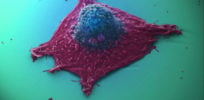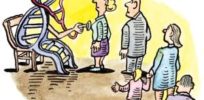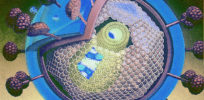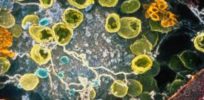New Scientist
New era of fast genetic engineering
Sequencing genomes has become easy. Understanding them remains incredibly hard. While the trickle of sequence information has turned into a ...
Infectious cancer contains 11k-year-old dog genes
Call it the Methuselah mutt. There are genes from a dog that lived 11,000 years ago in an infectious cancer ...

Giant leaps of evolution make cancer cells deadly
The complex invasion of multiple body tissues that occurs when cancer metastasizes is driven by huge leaps of evolution. Maybe ...
Diet can explain half of racial blood pressure puzzle
By studying metabolites in urine samples from 1559 US citizens, researchers identified differences between the two groups. As well as ...
Human meddling will spur the evolution of new species
A decade ago, ecologist Chris Thomas warned that climate change would wipe out a quarter of all species. Now he ...

Will public trust in personalized medicine suffer, an ethicist wonders
23andMe's personal DNA test kits have helped increase public interest in personalized medicine. But after the FDA demanded they stop ...
Preparing students to meet their genes in the classroom
How much information do you need before deciding whether to have your genome sequenced? In 2010, the University of California, ...
Stonehenge Man provides rare look at face of British prehistory
Tourists entering English Heritage's new £27 million visitor centre at Stonehenge will quickly confront its most spectacular exhibit – a ...
Will 2014 be year of the 1-million-year-old genome?
Dinosaurs resurrected using preserved DNA still only exist in Jurassic Park, but we're making great strides in sequencing the genomes ...
Aging might be reversible
Imagine if we could turn back time. A team that has identified a new way in which cells age has ...
Smart genes: Nature more than nurture determines exam success
A controversial study on twins claims to provide strong evidence that genetic inheritance has a bigger impact on exam success ...
How to grow brains in a lab
Bioengineers dream of growing spare parts for our worn-out or diseased bodies. They have already succeeded with some tissues, but ...
400,000 year-old human DNA revolutionizing view of evolution
Deep inside the Atapuerca cave system in northern Spain, 30 metres beneath the surface, lies the Sima de los Huesos, ...
New techniques swap out codons across the genome
The language of life has been rewritten. A bacterium has had its genome recoded so that one of its genetic ...
Earth’s first life may have sprung up in ice
If you thought life evolved in bubbling hot springs, think again. Pieces of RNA have been made that can copy ...
‘Bubble kid’ success puts gene therapy back on track
Severe combined immunodeficiency was the first condition to be treated with gene therapy more than 20 years ago. A virus was ...

Is HIV the hero that’ll help gene therapy rise above the hype?
We're seeing some successes in gene therapy, but cost remains an issue. Could a modified version of HIV save the ...
Scientists ID new humpback dolphin species
It has always been difficult to determine how many humpback dolphin species there are. Many biologists think there are just ...
Creator of Golden Rice weighs in on the continuing debate
(Summary) Ingo Potrykus, chairman of the Golden Rice Humanitarian Board and former professor of plant sciences at the Swiss Federal ...
Hefty twins shed light on obesity paradox
They are identical in almost every way, except one twin is fat and the other is thin. Now a study ...
Neural stem cells pulled from rat’s brain using magnet
It's like pulling a rabbit out of a hat. Researchers have reached inside the brain of a rat and pulled ...

23andMe patents DNA tool for ‘desigining’ a baby
23andMe received a patent for their family inheritance tool, which suggests likely traits for a couple's offspring. But the patent, ...
Mice get replacement glands, grown from scratch
It'll make you cry, or salivate. Takashi Tsuji at Tokyo University of Science in Japan, and colleagues have created tear and salivary ...
Glowing sperm go head to head in fight to be the daddy
Inside this fruit fly reproductive tract, a battle is taking place – a battle of sperm. In turquoise are the ...
DNA-grabbing bacteria hint at early phase of evolution
Parts of us may never die – not quite, anyway. Lab tests involving microbes and a mammoth bone have shown ...
New Scientist: GM insects are a safe and effective tool
Opponents of genetic modification are up in arms again, this time over the proposed release of GM flies in Spain ...

Warning sounded over three-parent IVF safety
Just three months after the UK started working toward mitochondria replacement therapy to circumvent genetic diseases, researchers are sounding an ...
Girl who feels no pain could inspire new painkillers
A girl who does not feel physical pain has helped researchers identify a gene mutation that disrupts pain perception. The ...

